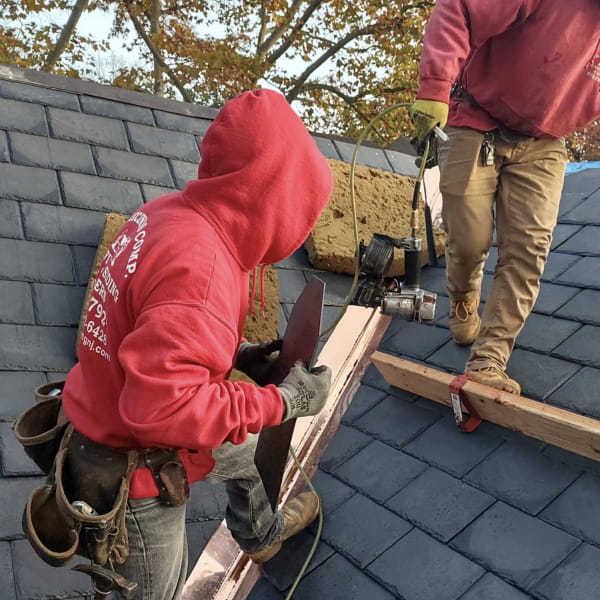Just How to Examine Various Roof Alternatives for Your Building Needs
Examining roof covering options for your building calls for a thorough approach that thinks about various variables such as the intended use of the structure, local environment problems, and product attributes. It is important to evaluate the advantages and disadvantages of different roof types, from asphalt shingles to metal and clay ceramic tiles, while likewise factoring in preliminary costs and lasting upkeep. Furthermore, comprehending energy efficiency and aesthetic allure can influence your choice. As you contemplate these factors to consider, one concern remains: which elements will eventually assist your option for a lasting and visually pleasing roof remedy?
Assessing Your Structure's Demands
To properly review roofing options, begin by thoroughly examining your structure's needs. Start by thinking about the building's intended usage, as different structures might require varying roof covering requirements. As an example, residential roofs usually prioritize visual appeals and insulation, while industrial buildings might focus on longevity and load-bearing capacity.
Following, examine the regional environment conditions that will affect roof covering efficiency. Factors such as temperature variations, rainfall levels, and wind patterns can influence product selection and layout. A roofing system that masters a temperate climate may not perform too in locations susceptible to heavy snowfall or severe warm.
Furthermore, examine the structural honesty of your structure. Make sure that the existing framework can sustain the picked roof materials, particularly if thinking about much heavier choices. It is additionally important to assess any type of local building ordinance or guidelines that may determine particular demands for roofing systems.

Contrasting Roofing Materials
As soon as an extensive analysis of your building's demands has actually been completed, the next step entails contrasting various roofing materials. Each product uses distinctive benefits and disadvantages, making it necessary to align your option with your certain demands and conditions.
Asphalt roof shingles are commonly acknowledged for their cost and simplicity of setup, making them a prominent choice for property buildings. On the various other hand, steel roofing, understood for its sturdiness and durability, can stand up to rough climate problems but may include a higher initial financial investment.
Clay and concrete tiles supply superb thermal insulation and aesthetic allure, specifically for Mediterranean-style style, yet they need a more robust structural support because of their weight. Timber drinks deal an all-natural look and good insulation buildings yet might demand much more upkeep and are vulnerable to fire risks.
Evaluating Price and Spending Plan
Analyzing your roofing options requires a cautious examination of cost and budget plan considerations. The overall allocate a roof covering task consists of numerous elements, including product expenses, labor expenditures, upkeep, and potential long-term cost savings. It is necessary to establish a clear budget before discovering particular roof covering products, as this will certainly assist the decision-making process and assist you stay clear of overspending.
Begin by obtaining quotes from multiple contractors to comprehend labor prices in your area. Make sure that these estimates include all needed services, such as removal of the old roof covering, setup, and any type of additional attributes, like insulation or ventilation enhancements - Roofer. Next, evaluate the price of different roof materials, taking into consideration both first setup prices and expected life-span

Comprehending Power Performance
Power effectiveness plays a critical role in the selection of roof covering materials and systems, significantly affecting both power intake and general comfort within a structure. A well-chosen roof can boost thermal performance, reducing the requirement for home heating and cooling systems, which consequently lowers energy expenses and minimizes environmental influence.
When evaluating roofing choices, take into consideration products that mirror instead of soak up heat. Light-colored or reflective roof covering products can significantly decrease roofing system surface temperatures, leading to reduced power use during hot months. Additionally, proper insulation and air flow are necessary to maximize the energy efficiency of the whole roof covering system. Insulation avoids warm transfer, while air flow reduces heat build-up in the attic space.
One more crucial element is the roof's durability and maintenance demands. Resilient materials that need much less frequent replacement contribute to long-term power financial savings. In addition, the energy performance of a roof can additionally be assessed with its conformity with well-known sustainability scores such as ENERGY STAR or LEED.
Thinking About Visual Charm
A roof covering's visual appeal substantially influences the total look of a structure, enhancing its building style and enhancing visual allure. Roofing Contractor. When evaluating roof alternatives, it is important to consider exactly how the picked product, color, and layout will integrate with the existing framework and area. A properly designed roofing system can raise also the easiest of structures, transforming them right into visual i loved this centerpieces
Various roof products use numerous visual high qualities. For instance, standard tiles might evoke a traditional appeal, while metal roofing can give a contemporary, streamlined look. In addition, the color of the roofing product plays an important function; lighter tones can make a structure show up more spacious, while darker tones may develop a cozier ambiance.
Moreover, building elements, such as dormers and eaves, can improve the roofing's visual impact. It is a good idea to seek advice from specialist developers or architects to make sure the picked roof alternative lines up with the overall design intent. helpful site Inevitably, a roofing system should not only offer functional advantages yet likewise contribute positively to the structure's aesthetic, showing the owner's taste and the personality of the surrounding atmosphere.
Conclusion
